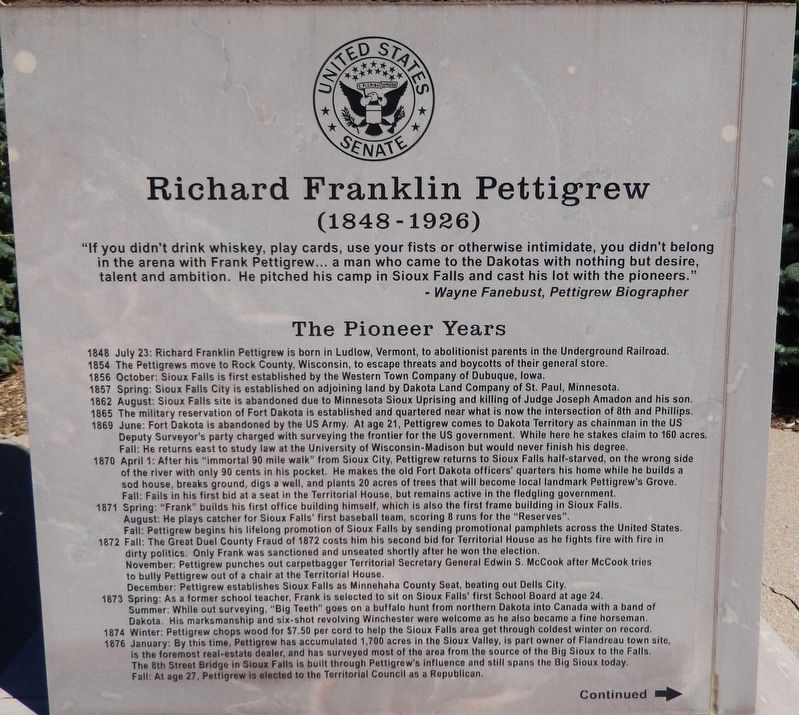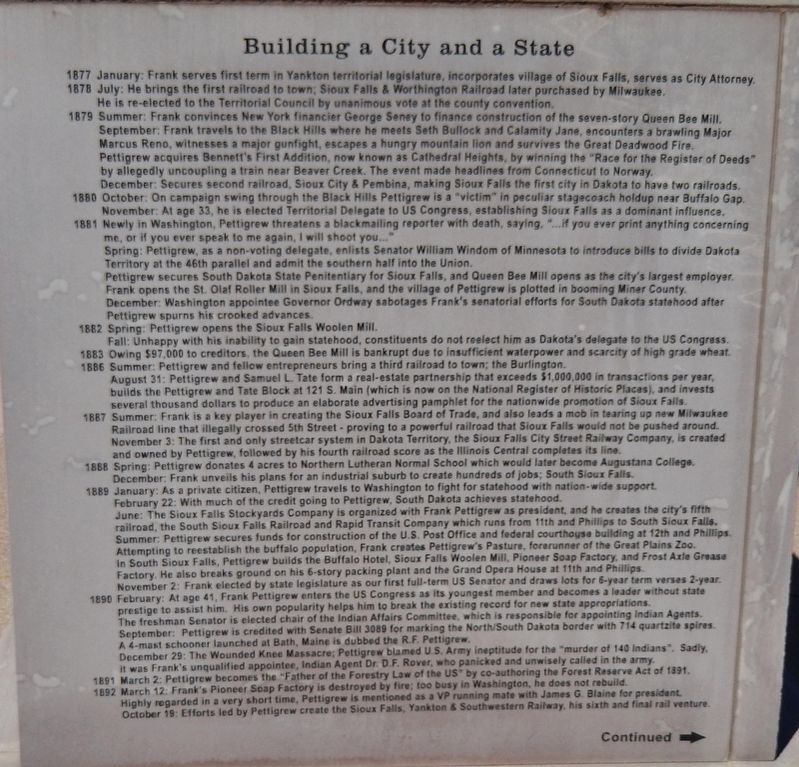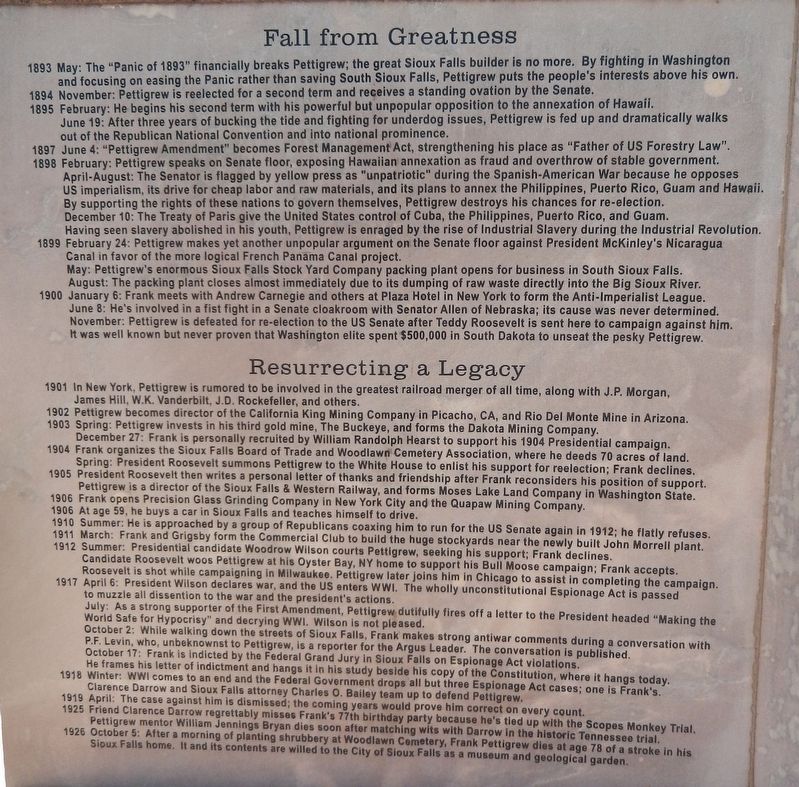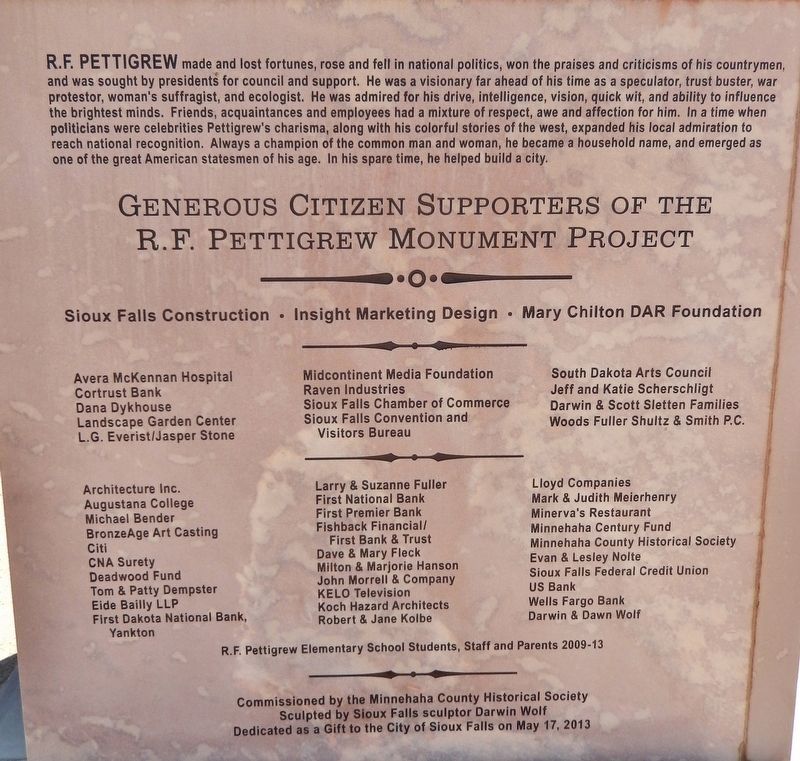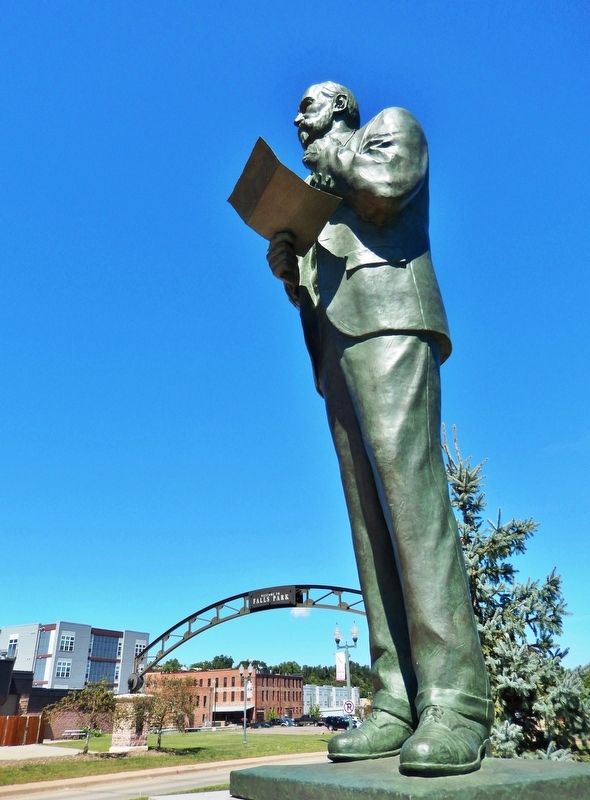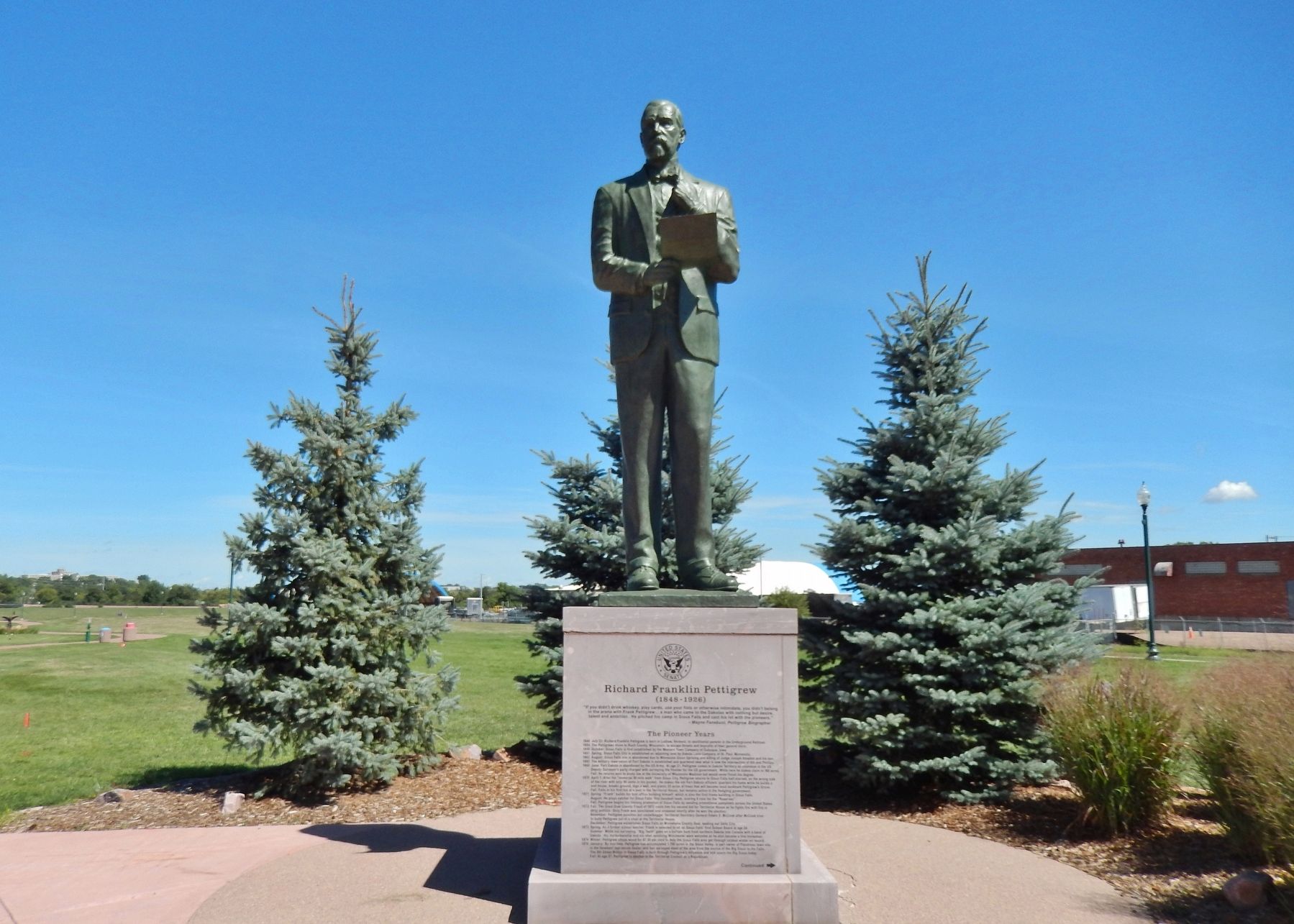Downtown in Sioux Falls in Minnehaha County, South Dakota — The American Midwest (Upper Plains)
Richard Franklin Pettigrew
(1848 - 1926)
(panel 1)
”If you didn't drink whiskey, play cards, use your fists or otherwise intimidate, you didn't belong in the arena with Frank Pettigrew… a man who came to the Dakotas with nothing but desire, talent and ambition. He pitched his camp in Sioux Falls and cast his lot with the pioneers.”
- Wayne Fanebust, Pettigrew Biographer
The Pioneer Years
1848 July 23: Richard Franklin Pettigrew is born in Ludlow, Vermont, to abolitionist parents in the Underground Railroad.
1854 The Pettigrews move to Rock County, Wisconsin, to escape threats and boycotts of their general store.
1856 October: Sioux Falls is first established by the Western Town Company of Dubuque, Iowa.
1857 Spring: Sioux Falls City is established on adjoining land by Dakota Land Company of St. Paul, Minnesota.
1862 August: Sioux Falls site is abandoned due to Minnesota Sioux Uprising and killing of Judge Joseph Amadon and his son.
1865 The military reservation of Fort Dakota is established and quartered near what is now the intersection of 8th and Phillips.
1869 June: Fort Dakota is abandoned by the US Army. At age 21, Pettigrew comes to Dakota Territory as chairman in the US Deputy Surveyor's party charged with surveying the frontier for the US government. While here he stakes claim to 160 acres. Fall: He returns east to study law at the University of Wisconsin-Madison but would never finish his degree.
1870 April 1: After his "immortal 90 mile walk" from Sioux City, Pettigrew returns to Sioux Falls half-starved, on the wrong side of the river with only 90 cents in his pocket. He makes the old Fort Dakota officers' quarters his home while he builds a sod house, breaks ground, digs a well, and plants 20 acres of trees that will become local landmark Pettigrew's Grove. Fall: Fails in his first bid at a seat in the Territorial House, but remains active in the fledgling government.
1871 Spring: "Frank" builds his first office building himself, which is also the first frame building in Sioux Falls. August: He plays catcher for Sioux Falls' first baseball team, scoring 8 runs for the "Reserves". Fall: Pettigrew begins his lifelong promotion of Sioux Falls by sending promotional pamphlets across the United States.
1872 Fall: The Great Duel County Fraud of 1872 costs him his second bid for Territorial House as he fights fire with fire in dirty politics. Only Frank was sanctioned and unseated shortly after he won the election. November: Pettigrew punches out carpetbagger Territorial Secretary General Edwin S. McCook after McCook tries to bully Pettigrew out of a chair at the Territorial House. December: Pettigrew establishes Sioux Falls as Minnehaha County Seat, beating out Dells City.
1873 Spring: As a former school teacher, Frank is selected to sit on Sioux Falls' first School Board at age 24. Summer: While out surveying, "Big Teeth" goes on a buffalo hunt from northern Dakota into Canada with a band of Dakota. His marksmanship and six-shot revolving Winchester were welcome as he also became a fine horseman.
1874 Winter: Pettigrew chops wood for $7.50 per cord to help the Sioux Falls area get through coldest winter on record.
1876 January: By this time, Pettigrew has accumulated 1,700 acres in the Sioux Valley, is part owner of Flandreau town site, is the foremost real-estate dealer, and has surveyed most of the area from the source of the Big Sioux to the Falls. The 8th Street Bridge in Sioux Falls is built through Pettigrew's influence and still spans the Big Sioux today. Fall: At age 27, Pettigrew is elected to the Territorial Council as a Republican.
(panel 2)
Building a City and a State
1877 January: Frank serves first term in Yankton territorial legislature, incorporates village of Sioux Falls, serves as City Attorney.
1878 July: He brings the first railroad to town. Sioux falls & Worthington Railroad later purchased by Milwaukee He is re-elected to the Territorial Council by unanimous vote at the county convention.
1879 Summer: Frank convinces New Yore financier George gently to finance construction of the seven-story Queen Bee Mill. September: Frank travels to the Black Hale where he meets Seth Bullock and Calamity Jane, encounters a brawling Major Marcus Reno, witnesses a major gunfight, escapes a hungry mountain lion and survives the Great Deadwood Fire. Pettigrew acquires Bennett's First Addition, now known as Cathedral Heights, by winning the “Race for the Register of Deeds” by allegedly uncoupling a train near Beaver Creek. The event made headlines from Connecticut to Norway. December: Secures second railroad, Sioux City & Pembina, making Sioux Falls the first city in Dakota to have two railroads.
1880 October: On campaign swing through the Black Hills Pettigrew is a “victim” in peculiar stagecoach holdup near Buffalo Gap. November: At age 33, he is elected Territorial Delegate to US Congress, establishing Sioux Falls as a dominant influence.
1881 Newly in Washington, Pettigrew threatens a blackmailing reporter with death, saying, "if you ever print anything concerning me, or if you ever speak to me again. I will shoot you.” Spring: Pettigrew, as a non-voting delegate, enlists Senator William Windom of Minnesota to introduce bills to divide Dakota Territory at the 46th parallel and admit the southern half into the Union. Pettigrew secures South Dakota State Penitentiary for Sioux Falls, and Queen Bee Mill opens as the city's largest employer. Frank opens the St Olaf Roller Mill in Sioux Falls, and the village of Pettigrew is plotted in booming Minor County. December: Washington appointee Governor Ordway sabotages Frank's senatorial efforts for South Dakota statehood after Pettigrew spurns his crooked advances
1882 Spring: Pettigrew opens the Sioux Falls Woolen Mill. Fall: Unhappy with his inability to gain statehood, constituents do not reelect him as Dakota's delegate to the US Congress.
1883 Owing $97,000 to creditors, the Queen Bee Mill is bankrupt due to insufficient waterpower and scarcity of high grade wheat.
1886 Summer: Pettigrew and fellow entrepreneurs bring a third railroad to town; the Burlington. August 31: Pettigrew and Samuel L. Tate form a real-estate partnership that exceeds 11,000,000 in transactions per year, builds the Pettigrew and Tate Block at 121 S Main (which is now on the National Register of Historic Places), and invests several thousand dollars to produce an elaborate advertising pamphlet for the nationwide promotion of Sioux Falls.
1887 Summer: Frank is a key player in creating the Sioux Falls Board of Trade, and also leads a mob in tearing up new Milwaukee Railroad line that illegally crossed 5th Street, proving to a powerful railroad that Sioux Falls would not be pushed around. November 3: The first and only streetcar system in Dakota Territory, the Sioux Falls City Street Railway Company, is created and owned by Pettigrew, followed by his fourth railroad score as the Illinois Central completes its line.
1888 Spring: Pettigrew donates 4 acres to Northern Lutheran Normal School which would later become Augustana College. December: Frank unveils his plans for an industrial suburb to create hundreds of jobs; South Sioux Falls.
1889 January: As a private citizen, Pettigrew travels to Washington to fight for statehood with nation-wide support. February 22: With much of the credit going to Pettigrew, South Dakota achieves statehood. June: The Sioux Falls Stockyards Company is organized with Frank Pettigrew as president, and he creates the city's fifth railroad, the South Sioux Falls Railroad and Rapid Transit Company which runs from 11th and Phillips to South Sioux Falls. Summer: Pettigrew secures funds for construction of the U. S. Post Office and federal courthouse building at 12th and Phillips. Attempting to reestablish the buffalo population, Frank creates Pettigrew's Pasture, forerunner of the Great Plains Zoo. In South Sioux Falls, Pettigrew builds the Buffalo Hotel, Sioux Falls Woolen Mill, Pioneer Soap Factory, and Frost Axle Grease Factory. He also breaks ground on his 6-story packing plant and the Grand Opera House at 11th and Phillips. November 2: Frank elected by state legislature as our first full-term US Senator and draws lots for 6-year term versus 2-year.
1890 February: At age 41, Frank Pettigrew enters the US Congress as its youngest member and becomes a leader without state prestige to assist him. His own popularity helps him to break the existing record for new state appropriations. The freshman Senator is elected chair of the Indian Affairs Committee which is responsible for appointing Indian Agents. September: Pettigrew is credited with Senate Bill 3089 for marking the North/South Dakota border with 714 quartzite spires. A 4-mast schooner launched at Bath, Maine is dubbed the R F Pettigrew. December 29: The Wounded Knee Massacre; Pettigrew blamed U S Amry ineptitude for the “murder of 140 Indians.” Sadly, it was Frank's unqualified appointee, Indian Agent Dr. D.F. Rover, who panicked and unwisely, called in the army.
1891 March 2: Pettigrew becomes the “Father of the Forestry Law of the US” by co-authoring the Forest Reserve Ad of 1191.
1892 March 12: F rank's Pioneer Soap Factory is destroyed by fire, too busy in Washington, he does not rebuild. Highly regarded in a very short time, Pettigrew is mentioned as a VP running mate with James G. Blaine for president. October 19: Efforts led by Pettigrew create the Sioux Falls, Yankton & Southwestern Railway, his sixth and final rail venture.
(panel 3)
Fall from Greatness
1893 May: The "Panic of 1893" financially breaks Pettigrew; the great Sioux Falls builder is no more. By fighting in Washington and focusing on easing the Panic rather than saving South Sioux Falls, Pettigrew puts the people's interests above his own.
1894 November: Pettigrew is reelected for a second term and receives a standing ovation by the Senate.
1895 February: He begins his second term with his powerful but unpopular opposition to the annexation of Hawaii. June 19: After three years of bucking the tide and fighting for underdog issues, Pettigrew is fed up and dramatically walks out of the Republican National Convention and into national prominence.
1897 June 4: "Pettigrew Amendment" becomes Forest Management Act, strengthening his place as "Father of US Forestry Law".
1898 February: Pettigrew speaks on Senate floor, exposing Hawaiian annexation as fraud and overthrow of stable government. April-August: The Senator is flagged by yellow press as "unpatriotic" during the Spanish-American War because he opposes US imperialism, its drive for cheap labor and raw materials, and its plans to annex the Philippines, Puerto Rico, Guam and Hawaii. By supporting the rights of these nations to govern themselves, Pettigrew destroys his chances for re-election. December 10: The Treaty of Paris gives the United States control of Cuba, the Philippines, Puerto Rico, and Guam. Having seen slavery abolished in his youth, Pettigrew is enraged by the rise of Industrial Slavery during the Industrial Revolution.
1899 February 24: Pettigrew makes yet another unpopular argument on the Senate floor against President McKinley's Nicaragua Canal in favor of the more logical French Panama Canal project. May: Pettigrew's enormous Sioux Falls Stock Yard Company packing plant opens for business in South Sioux Falls. August: The packing plant closes almost immediately due to its dumping of raw waste directly into the Big Sioux River.
1900 January 6: Frank meets with Andrew Carnegie and others at Plaza Hotel in New York to form the Anti-Imperialist League. June 8: He's involved in a fist fight in a Senate cloakroom with Senator Allen of Nebraska; its cause was never determined. November: Pettigrew is defeated for re-election to the US Senate after Teddy Roosevelt is sent here to campaign against him. It was well known but never proven that Washington elite spent $500,000 in South Dakota to unseat the pesky Pettigrew.
Resurrecting a Legacy
1901 In New York, Pettigrew is rumored to be involved in the greatest railroad merger of all time, along with J.P. Morgan, James Hill, W.K. Vanderbilt, J.D. Rockefeller, and others.
1902 Pettigrew becomes director of the California King Mining Company in Picacho, CA, and Rio Del Monte Mine in Arizona.
1903 Spring: Pettigrew invests in his third gold mine, The Buckeye, and forms the Dakota Mining Company. December 27: Frank is personally recruited by William Randolph Hearst to support his 1904 Presidential campaign.
1904 Frank organizes the Sioux Falls Board of Trade and Woodlawn Cemetery Association, where he deeds 70 acres of land. Spring: President Roosevelt summons Pettigrew to the White House to enlist his support for reelection; Frank declines.
1905 President Roosevelt then writes a personal letter of thanks and friendship after Frank reconsiders his position of support. Pettigrew is a director of the Sioux Falls & Western Railway, and forms Moses Lake Land Company in Washington State.
1906 Frank opens Precision Glass Grinding Company in New York City and the Quapaw Mining Company.
1906 At age 59, he buys a car in Sioux Falls and teaches himself to drive.
1910 Summer: He is approached by a group of Republicans coaxing him to run for the US Senate again, in 1912; he flatly refuses.
1911 March: Frank and Grigsby form the Commercial Club to build the huge stockyards near the newly built John Morrell plant.
1912 Summer: Presidential candidate Woodrow Wilson courts Pettigrew, seeking his support; Frank declines. Candidate Roosevelt woos Pettigrew at his Oyster Bay, NY home to support his Bull Moose campaign; Frank accepts. Roosevelt is shot while campaigning in Milwaukee. Pettigrew later joins him in Chicago to assist in completing the campaign.
1917 April 6: President Wilson declares war, and the US enters WWI. The wholly unconstitutional Espionage Act is passed to muzzle all dissention to the war and the president's actions. July: As a strong supporter of the First Amendment, Pettigrew dutifully fires off a letter to the President headed “Making the World Safe for Hypocrisy” and decrying WWI. Wilson is not pleased. October 2: While walking down the streets of Sioux Falls, Frank makes strong antiwar comments during a conversation with P.F. Levin, who, unbeknownst to Pettigrew, is a reporter for the Argus Leader. The conversation is published. October 17: Frank is indicted by the Federal Grand Jury in Sioux Falls on Espionage Act violations. He frames his letter of indictment and hangs it in his study beside his copy of the Constitution, where it hangs today.
1918 Winter: WWI comes to an end and the Federal Government drops all but three Espionage Act cases; one is Frank's. Clarence Darrow and Sioux Falls attorney Charles O. Bailey team up to defend Pettigrew.
1919 April: The case against him is dismissed; the coming years would prove him correct on every count.
1925 Friend Clarence Darrow regrettably misses Frank's 77th birthday party because he's tied up with the Scopes Monkey Trial. Pettigrew mentor William Jennings Bryan dies soon after matching wits with Darrow in the historic Tennessee trial.
1926 October 5: After a morning of planting shrubbery at Woodlawn Cemetery, Frank Pettigrew dies at age 78 of a stroke in his Sioux Falls home. It and its contents are willed to the City of Sioux Falls as a museum and geological garden.
(panel 4)
R.F. Pettigrew made and lost fortunes, rose and fell in national politics, won the praises and criticisms of his countrymen, and was sought by presidents for council and support. He was a visionary far ahead of his time as a speculator, trust buster, war protestor, woman's suffragist, and ecologist. He was admired for his drive, intelligence, vision, quick wit, and ability to influence the brightest minds. Friends, acquaintances and employees had a mixture of respect, awe and affection for him. In a time when politicians were celebrities Pettigrew's charisma, along with his colorful stories of the west, expanded his local admiration to reach national recognition. Always a champion of the common man and woman, he became a household name, and emerged as one of the great American statesmen of his age. In his spare time, he helped build a city.
R.F. Pettigrew Monument Project
Sioux Falls Construction • Insight Marketing Design • Mary Chilton DAR Foundation
Avera McKennan Hospital • Cortrust Bank • Dana Dykhouse • Landscape Garden Center • L.G. Everist/Jasper Stone • Architecture Inc. • Augustana College • Michael Bender • BronzeAge Art Casting • Citi • CNA Surety • Deadwood Fund • Tom & Patty Dempster • Eide Bailly LLP • First Dakota National Bank, Yankton • Midcontinent Media Foundation • Raven Industries • Sioux Falls Chamber of Commerce • Sioux Falls Convention and Visitors Bureau • Larry & Suzanne Fuller • First National Bank • First Premier Bank • Fishback Financial/First Bank & Trust • Dave & Mary Fleck • Milton & Marjorie Hanson • John Morrell & Company • KELO Television • Koch Hazard Architects • Robert & Jane Kolbe • South Dakota Arts Council • Jeff and Katie Scherschligt • Darwin & Scott Sletten Families • Woods Fuller Shultz & Smith P.C. • Lloyd Companies • Mark & Judith Meierhenry • Minerva's Restaurant • Minnehaha Century Fund • Minnehaha County Historical Society • Evan & Lesley Nolte • Sioux Falls Federal Credit Union • US Bank • Wells Fargo Bank • Darwin & Dawn Wolf
R.F. Pettigrew Elementary School Students, Staff and Parents 2009-13
Commissioned by the Minnehaha County Historical Society
Sculpted by Sioux Falls sculptor Darwin Wolf
Dedicated as a Gift to the City of Sioux Falls on May 17, 2013
Erected 2013 by The Minnehaha County Historical Society and Mary Chilton Daughters of the American Revolution Foundation (DAR) and others.
Topics and series. This historical marker is listed in these topic lists: Abolition & Underground RR • Native Americans • Railroads & Streetcars • Settlements & Settlers. In addition, it is included in the Daughters of the American Revolution, the Former U.S. Presidents: #25 William McKinley, the Former U.S. Presidents: #26 Theodore Roosevelt, and the Former U.S. Presidents: #28 Woodrow Wilson series lists.
Location. 43° 33.159′ N, 96° 43.594′ W. Marker is in Sioux Falls, South Dakota, in Minnehaha County. It is in Downtown. Marker is on North Phillips Avenue north of West 5th Street, on the right when traveling north. Monument, statue and marker are located on the Falls Park walkway just east of North Phillips Avenue. Touch for map. Marker is in this post office area: Sioux Falls SD 57104, United States of America. Touch for directions.
Other nearby markers. At least 8 other markers are within walking distance of this marker. President William McKinley (within shouting distance of this marker); Phillips to the Falls (within shouting distance of this marker); Jewett Bros. & Jewett Warehouse (within shouting distance of this marker); The Andrew Kuehn Company (about 500 feet away, measured in a direct line); The Coliseum (about 500 feet away); Dakota Iron Store (about 500 feet away); John Deere (about 600 feet away); President Woodrow Wilson (about 600 feet away). Touch for a list and map of all markers in Sioux Falls.
More about this marker. Marker consists of a larger-than-life metal sculpture standing upon a large engraved stone pedestal with each of the 4 pedestal side panels carrying a portion of the text.
Credits. This page was last revised on May 5, 2023. It was originally submitted on October 4, 2018, by Cosmos Mariner of Cape Canaveral, Florida. This page has been viewed 495 times since then and 50 times this year. Photos: 1, 2, 3, 4, 5, 6. submitted on October 7, 2018, by Cosmos Mariner of Cape Canaveral, Florida. • Andrew Ruppenstein was the editor who published this page.
